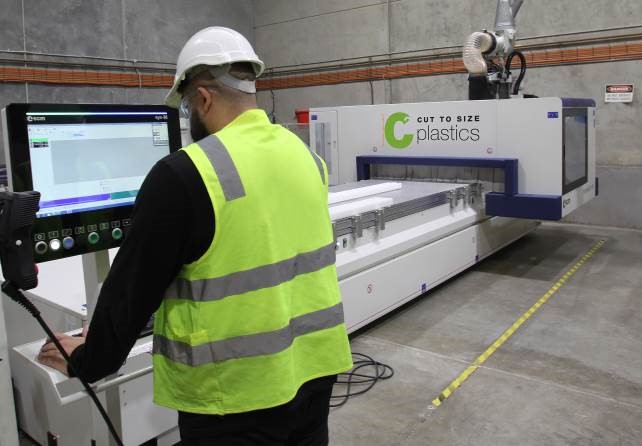New engineering plastics are allowing manufacturers and processors to maximise advantages in cost, safety and efficiency

Light, strong, and cost-effective engineering plastics are continuing to supplant metals in many machinery, componentry and architectural and construction applications, with manufacturers and processors equipping themselves to maximise advantages in applications where outstanding hygiene, no corrosion, low friction, automation, deterioration resistance and safety are critical.
“Australia and New Zealand are starting to catch up with pan-Asia and global trends towards the use of engineering plastics in expanding uses to which they are eminently suited. Metals are great for some applications, but manufacturers, processors and building specifiers here are waking up to opportunities to optimise their low-maintenance infrastructure and automation applications with plastics,” says engineering plastics innovator Laurie Green, Managing Director of Cut To Size Plastics.
Mr Green’s company – which has more than 40 years’ experience in engineering plastics applications throughout the Asia-pacific – has just launched a new website to help groups such as engineers, architects, operations managers, safety managers and others to decide whether plastics can deliver the benefits they need and to further extend technical support to specifiers who work with high performance and engineering plastics. The site is linked to subsidiary Hercules Engineering, which manufactures cost-efficient low-maintenance bearings for architectural and engineering applications ranging from hospitals, high-rise and landmarks such as the Sydney Opera House, through to road, rail, bridge, tank and pipeline infrastructure in Australia, Asia and Africa.
Mr Green says plastics have long had a place in safety applications, ranging from machinery guards and electrically protected products, right through to light and easily replaced plummer blocks housing shafts, as well as low-wear, low friction bulk handling equipment, guides and liners to help prevent blockages and hazardous clearing operations, which can bedevil mining, food and beverage dry product and diverse bulk handling applications.
“Automation and the search for cost-efficiency are also driving change in plastics engineering. Increasingly, engineers, architects and machinery fabricators are open to innovation, rather than being rusted on to the past. And new plastics formulations are emerging every year with designed-in attributes that optimise them for particular applications,” says Mr Green, whose company distributes advanced materials of international leaders in plastics technology including Licharz, Gehr and Beck-Wefapress.
Expansion and innovation
Recent Cut To Size Plastics innovations include the introduction of a new high-speed, vibration-free Morbidelli Author M100F heavy duty CNC router which offers unmatched finishing quality and rapid production turnaround for the company’s Asia-Pacific markets. It is also currently introducing Wefapress’ globally proven Flex Cover ranges of ultra-high molecular weight polyethylenes (UHMWPE) that have been chemically modified to make this tough, light material particularly suitable for high-temperature applications. the Wefapress Flex Cover range is typically eight times lighter than comparable steel liners used to curtail friction, wear and material flow challenges in diverse applications requiring no moisture absorption, outstanding chemical resistance and corrosion prevention.
“The important thing is to approach engineering plastics with an open mind, knowing that there are some applications for which metals will be superior and others where plastics will have the big advantages,” says Mr Green.
“For example, the particularly low melting point and high malleability of plastic allows these materials to be easily formed into a wide variety of complex shapes; thereby contributing to the ease of forming this material without requiring the use of any forming or machining procedures. Further, plastic materials also typically exhibit a greater chemical resistance compared with metals against potentially hazardous chemicals, such as those that cause oxidation or rusting when applied to metals and which can be a real hazard or downtime contributor in industries such as food and beverage and mining. Overall, plastic materials can be produced at a much faster rate as compared to their metal counterparts at a lower cost,” says Mr Green, whose company has invested its experience in its new website, which has simple and functional navigation and useful technical information, such as:
- Typical Plastic Properties
- Tips for drilling Acrylic
- Plastics Pyramid
- List of Material Abbreviations
- Shore Hardness Scale
- Scotchply Thickness
- Plastic Properties Comparison
- Coefficient of Sliding Friction Against Steel
- How to Identify Plastics
- Performance Advantages of Plastics
Cut To Size Plastics and Hercules Engineering are committed to meeting Australian and International Quality Standards and to working within the guidelines issued by State WorkCover safety authorities.
This includes producing durable products that are clean, easy to handle and enhance OH&S conditions in applications such as maintenance and installation of machinery components and architectural and construction products for industries ranging from commercial and health building to food and beverage manufacturing and mining, mineral processing and bulk handling.
For further information, please contact Cut To Size Plastics Pty Ltd, Cnr Dursley and Fairfield Roads, Yennora, NSW Australia 2161, Ph: 1800 CUT2SIZE or, 61 – 2 9681 0400, fax 61 – 2 9681 0450, [email protected]




